How to Improve Employee Productivity? 15+ Ways

Want to improve employee productivity? An evergreen question every manager is trying to answer.
As employees are every organization’s most valuable asset, companies must always look for ways to allow their productive employees to be more successful at what they do, thereby enhancing productivity levels and contributing positively to the company culture.
But how can we secure high employee productivity? This article will cover the ideal list of best employee productivity exercises that work for every organization.
| Employee Productivity Exercises 🏋️ |
| 1. Implement regular wellness programs to support employee wellbeing. |
| 2. Develop a collaborative work environment to boost team productivity. |
| 3. Provide opportunities for skill development and training for new hires. |
| 4. Encourage open communication channels to discover and address issues promptly. |
| 5. Offer flexible work arrangements to accommodate diverse needs. |
| 6. Recognize and reward productive employees for their contributions. |
| 7. Continuously assess and optimize human resources policies and procedures. |
| 8. Cultivate a positive company culture that prioritizes employee satisfaction. |
| 9. Invest in tools and technologies to streamline workflows and enhance efficiency. |
| 10. Prioritize employee wellbeing initiatives and feedback to improve the bottom line. |
Enhanced productivity ensures operational efficiency and effective resource utilization. With improved productivity businesses commonly resolve issues such as:
- Decreased stress levels,
- Heightened job satisfaction,
- Compatible work environment,
- Stronger team collaboration,
- and increased employee morale.
Try Buddy Punch For Free
What is Employee Productivity?

Employee productivity refers to the ability and effectiveness with which employees fulfill their tasks and responsibilities within an organization. It is a measure of how well employees utilize their skills, time, and resources to achieve desired outcomes and contribute to the company’s objectives.
Employee productivity primarily covers not only the quantity of work completed but also the quality and impact of that work.
It is influenced by various factors such as,
- workflow processes,
- management practices,
- work environment,
- employee engagement,
- and motivation levels.
By focusing on strategies to boost productivity, businesses can maximize their resources, increase profitability, and create a more positive and helpful work environment for their employees.
The Importance of Employee Productivity
When employees are more productive, they finish tasks efficiently, which leads to enhanced operations and resource allocation. This directly translates to improved profitability and competitiveness within the market.
Moreover, focusing on productivity ensures business goals are met on time, promoting growth opportunities.
By prioritizing employee productivity, small businesses can build a culture where everyone works well and achieves long-term success.
Causes of Low Productivity
Here are the main reasons for low productivity among employees.
1. Workload

A heavy workload can make it hard for employees to do their job well in small businesses.
When there’s too much work, this can make them more stressed and less motivated, and they might not get as much done.
To fix this problem, small businesses should try to give each employee a fair amount of work based on what they can handle and when they’re available.
Also, setting deadlines that make sense and giving employees enough help and resources is important.
Checking in with employees regularly and keeping communication open can help managers see if anyone’s struggling with their workload and fix it quickly.
This makes sure employees can do their best without feeling too stressed out.
You can also use employee scheduling software to allocate shifts to distribute the workload equally.
2. Lack of Motivation

When workers aren’t excited about their job or feel disconnected from it, they don’t try as hard and don’t perform as well.
This lack of motivation can happen for different reasons, such as not knowing what’s expected of them, not having chances to grow in their jobs, or not getting recognized or rewarded for their hard work.
To fix this, small businesses should focus on creating a positive and engaging environment.
They can do this by clearly explaining what the company wants to achieve, giving employees chances to learn and grow, and setting up programs to say thank you and reward good work.
When employees feel motivated and involved, small businesses can do better overall.
3. Poor Management

Poor management practices can greatly affect how well employees work in small businesses.
If leaders aren’t good at their jobs, if they micromanage too much, or if they don’t communicate well, it can make employees confused, frustrated, and uninterested in their work.
When employees feel like their employers don’t support or appreciate them, they’re less likely to do their best and might not care much about their jobs anymore.
To fix this, small businesses should spend money on training programs that help managers improve their leadership and communication skills with their teams.
Also, making an environment where everyone trusts each other, shares information openly, and works together can help managers have better relationships with their teams. This also lets employees feel like they’re in charge of their own work.
If small businesses encourage good management practices, they can make a nice workplace where employees feel important, excited, and ready to do their best.
4. Workplace Stress

Work stress is a big problem that makes it hard for people to work well.
High workloads, tight deadlines, interpersonal conflicts, and lack of work-life balance can all contribute to stress among employees.
Companies should focus on making a friendly work environment that helps employees feel good and strong.
This means setting up programs to manage stress, letting employees work flexibly, and giving them access to things like talking to someone for help or joining wellness activities.
Talking openly, making good relationships, and ensuring work and personal life are balanced can help reduce stress and improve people’s work.
5. Health Issues

Health issues, both physical and mental, can negatively impact employee productivity.
Chronic illnesses, injuries, mental health disorders, and lifestyle-related issues can all affect an employee’s ability to perform their job effectively.
Businesses should focus on keeping employees healthy to help with these health problems that affect work. This might mean giving them access to healthcare, encouraging good habits, and giving them ways to deal with stress and feeling down.
Also, making a friendly and open work environment where employees feel okay asking for help with health problems can help stop work from being affected too much by health issues.
What Are The Right Tools to Increase Employee Productivity?
You can use the following tools as a small business owner to improve employee productivity.
1. Project Management Software

Project management software helps teams work together better by making assigning tasks easier, keeping track of progress, and collaborating.
It’s like an online tool that helps everyone stay organized and focused on getting things done for a project.
Small businesses can use software like Trello, Asana, or Monday.com, which is easy to use and can be adjusted to fit the team’s needs.
By putting all the project information in one place and making it easier for everyone to talk to each other, this software makes the team more productive and efficient.
2. Communication Platforms

Effective communication is essential for teamwork and productivity, making communication platforms an essential tool for small businesses.
Platforms like Slack, Microsoft Teams, or Google Workspace are great because they let you send messages instantly, have video calls, and share files.
These tools make it easy to talk in one place, so you don’t have to send a bunch of emails back and forth. That way, decisions can be made quickly.
They have cool features like channels (chat rooms), threads (conversations within conversations), and connections with other tools to help everyone work together better.
3. Time Management Software
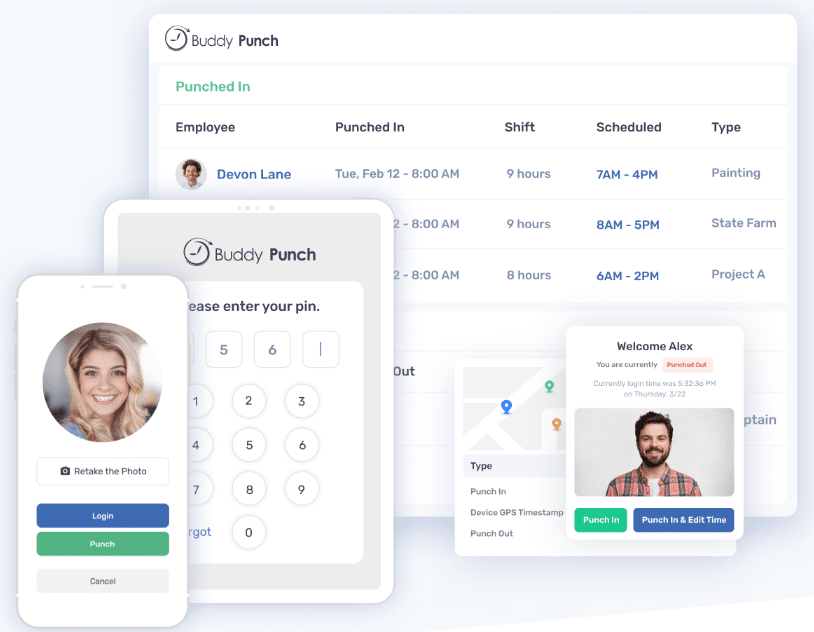
Time management software helps workers keep track of their time, decide what tasks to do first, and find ways to work better.
Tools like Buddy Punch help people see how they spend their time and find problems that slow them down.
By setting goals, making schedules, and looking at how they use their time, workers can do their jobs better and focus on the most important tasks.
Small businesses can use time management software to use their time better and finish projects on time.
Try Buddy Punch For Free
4. Task Automation and Chatbots

Automating tasks and using chatbots make work easier. Employees can spend more time on complicated and meaningful activities.
Tools like Zapier, IFTTT, and Microsoft Power Automate routine tasks like automatically entering data or organizing files. Chatbots in apps like Slack or Microsoft Teams immediately help with common questions and tasks.
15+ Ways to Boost Employee Productivity
Here are the top 15 ways to improve employee productivity in your teams.
1. Improve Employee Onboarding

A structured onboarding process for new employees is important for making them feel welcome.
Give them lots of training materials and someone to help them (like a mentor) so they can learn their new job.
Having one-on-one calls with new employees is also a good idea to help them feel more comfortable.
A strong onboarding process keeps new employees longer (employee retention) and helps them work better because they know what to do.
2. Set Clear Goals
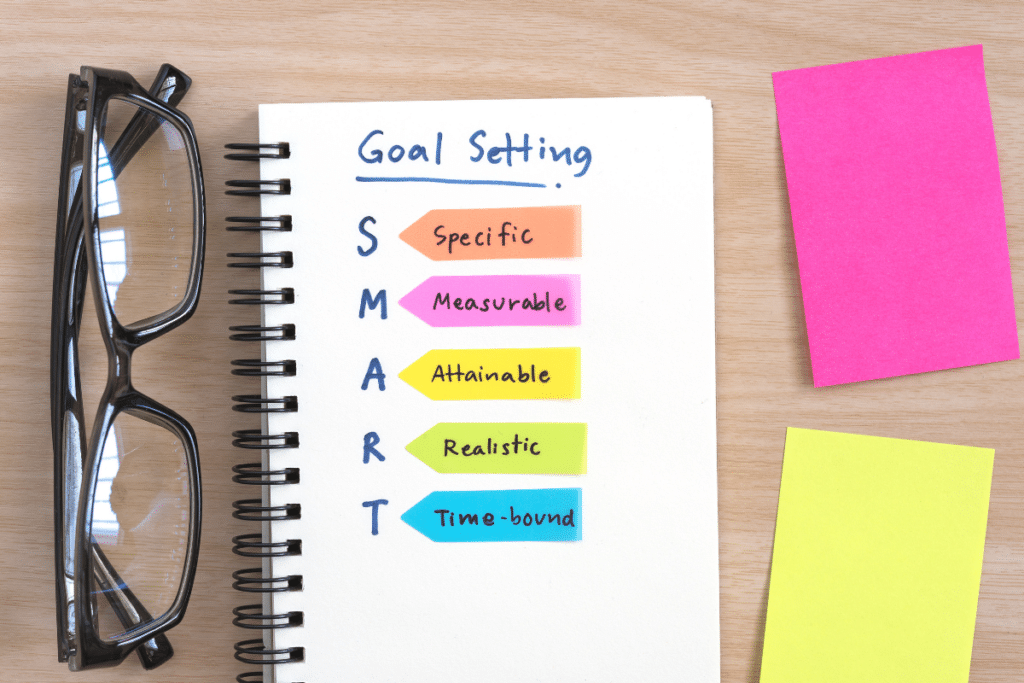
Clear, actionable goals will help your workers know exactly what’s expected of them and show them where you’re coming from with your requests.
Check in regularly to see if goals need changing and give feedback when they’re doing well. This transparency and direction will help prevent them from getting frustrated and burntout and inspire them to work harder.
3. Improve Workplace Conditions

A comfortable and helpful work environment maintains employee morale and productivity.
Pay attention to factors like making sure desks and chairs are comfy, and there’s enough natural light.
It’s also important to make everyone feel included and respected, so encourage people to talk openly and work together.
Showing that you care about your employees’ health and happiness by investing in wellness programs is a great way to boost productivity.
4. Allow Flexible Schedules
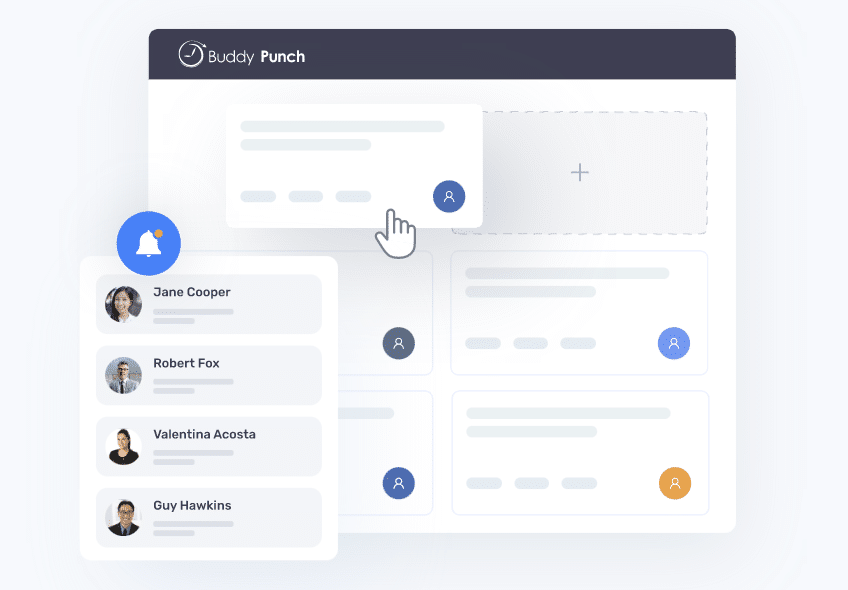
Offering flexible work plans, such as remote work options or flexible work hours, can empower employees to manage their time more effectively. This was especially useful during the pandemic (i.e., COVID-19).
Trusting employees to deliver results regardless of location or preferred work schedule, focusing on results instead of hours, is vital for business leaders striving to enhance employee experience and workplace productivity.
Flexible schedules not only let people work when it suits them but also alleviate the burden of commuting, contributing to the overall well-being of the employee and enhancing the team’s productivity.
Buddy Punch, an innovative employee scheduling app, facilitates the transition to hybrid work models by providing seamless communication and scheduling tools.

Its user-friendly interface empowers employees to manage their workday efficiently, ensuring open communication between team members and management. It allows managers to easily input shifts, assign tasks, and adjust schedules as needed.
Employees receive notifications of their assigned shifts and can request time off or swap shifts directly through the system.
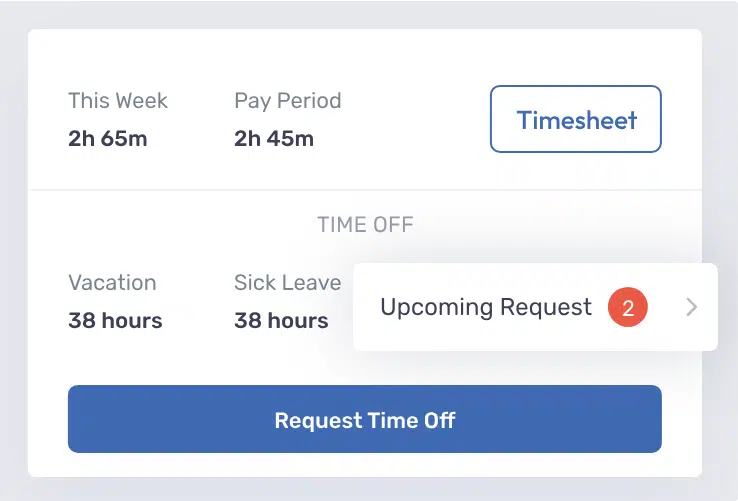
Additionally, Buddy Punch offers features such as shift templates and automated scheduling to streamline the process further. With real-time visibility into employee availability and shift coverage, managers can efficiently allocate resources and ensure optimal staffing levels.
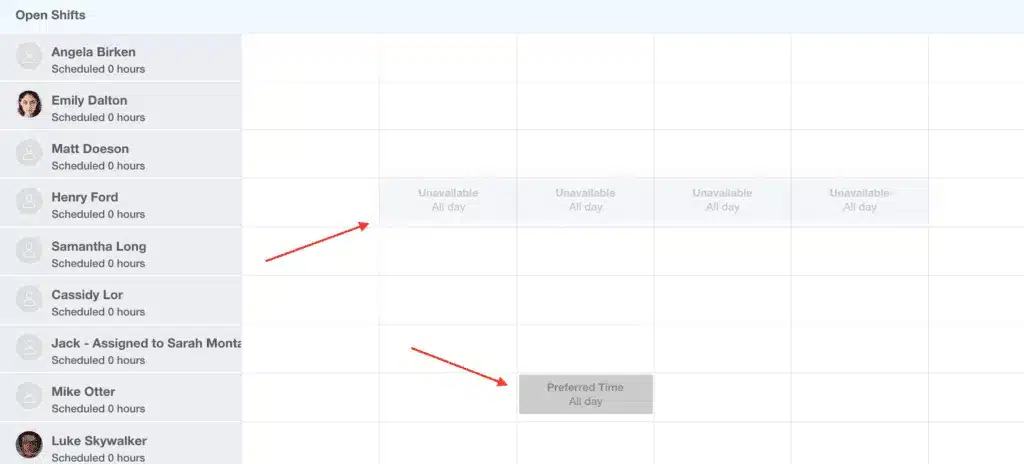
By offering perks like remote work options and flexible scheduling, businesses can attract and retain top talent, further bolstering employee empowerment and satisfaction.
In-office collaboration is still essential for certain tasks, but the flexibility offered by tools like Buddy Punch enables businesses to steer the complexities of the modern work environment.
Ready to give Buddy Punch a try?
For free trial, no credit card required.
5. Eliminate Distractions To Better Employee Performance

Identify and minimize distractions in the workplace, whether they are physical, digital, or environmental.
To help workers focus, use methods such as quiet spots, time management, and taking breaks from screens.
Recommend using productivity tools, such as planning time and deciding what’s most important, to minimize distractions and maximize efficiency.
A distraction-free work environment helps workers focus more, improving productivity and overall employee performance.
6. Come Up with Incentives and Rewards

Rewards and bonuses can motivate employees to work harder.
Express Gratitude
In a survey by career site Glassdoor.com, more than 2,000 people were asked what motivated them to work harder. The top answer? Appreciation.
81% of respondents said they feel motivated to work harder when their manager appreciates their work.
A simple “thank you” doesn’t cost anything and can motivate the team to do their best.
Reward Them
Studies show that rewarding employees for going the extra mile makes them more productive.
It also helps them feel more fulfilled and eager to contribute to the organization in a meaningful way. Even a $25 gift card can go a long way toward helping your workers feel valued and encouraged to keep up the good work.
7. Provide the Right Tools For Employee Training
Opt for things that will free up employees to do their best, like making their jobs easier. This means providing them with the right training and tools to excel in their roles and work efficiently.
Get good technology and software to make tasks easier. Teach your employees everything they need to know to do their jobs well.
You can use tools like Buddy Punch, a comprehensive time tracking and employee scheduling software.
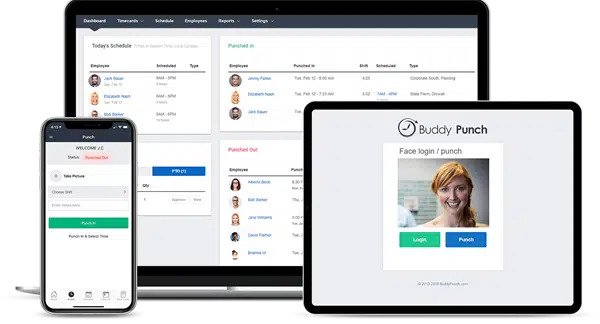
With Buddy Punch, employees can easily clock in and out, request time off, and swap shifts, streamlining attendance management. Managers gain real-time insights into employee hours, facilitating better resource allocation and performance tracking.
Equipping your team with Buddy Punch empowers them to manage their time effectively, boosting productivity and developing a positive work environment.
Ready to start a free trial?
No credit card required, all features included.
8. Stop Micromanaging

Micromanaging occurs when bosses control everything their workers do, which prevents them from being creative, reduces their productivity, and frustrates them.
Trusting your employees to finish tasks independently and providing guidance and support when needed is better.
Let your employees decide things and feel like they own their work, which makes them feel responsible and motivated.
Instead of focusing on every tiny detail of how tasks are done, focus on the results. This lets employees figure out the best ways to do things efficiently.
9. Improve Office Communication
Organize regular team meetings and use project management tools to ensure everyone can easily communicate.
Encourage people to speak up and share their thoughts so everyone feels like they’re part of the team.
Teach people how to listen well and solve problems when disagreements come up to make talking to each other easier.
Use technology to make communicating easier and keep everyone informed and aligned.
10. Encourage Self-Care
- Encourage breaks: Tell your employees to take short breaks during the day to rest and relax.
- Suggest exercise: Encourage your employees to move around and be active. This could be going for a walk during lunch or doing some stretches at their desk. Exercise helps reduce stress and keeps them healthy.
- Practice mindfulness: Teach your employees to focus on the present moment and relax their minds. This can be done via simple exercises like deep breathing or meditation.
- Offer resources: Give your employees access to programs that help them stay healthy and happy. This could include things like gym memberships, counseling services, or flexible work schedules.
- Lead by example: Show your employees that taking care of themselves is okay. Make sure you’re taking breaks, exercising, and managing your own stress. This sets a good example and encourages your employees to do the same.
11. Cut Unnecessary Meetings
Unnecessary meetings can take away time from important tasks and make productivity harder.
Consider whether each meeting is really needed and try other communication methods, like email or working together on documents.
Make sure meetings have clear plans and goals to keep them on track and useful.
Keep meetings short and help people make decisions and solve problems quickly.
Check regularly to see if you need all the meetings you have scheduled and ask people for their ideas on how to improve them or eliminate ones that aren’t needed.
12. Take Feedback

It’s really important to ask employees for their thoughts so we can find ways to improve and boost productivity.
Create open channels for feedback, such as surveys, suggestion boxes, or just talking one-on-one with managers.
Listen carefully to what employees say, and show them you’re willing to fix problems and make changes.
Encourage everyone to share helpful feedback and keep finding ways to make improvements.
Keep everyone updated on our changes based on employee feedback so they know their ideas are valued and acted upon.
13. Encourage Team Collaboration

Collaboration among team members promotes creativity, innovation, and productivity.
Create opportunities for your team to collaborate by doing team-building activities, sharing projects, and using spaces where they can work together.
Encourage everybody to talk openly and share their ideas with the team so you can use everyone’s different experiences and skills.
Provide collaboration platforms and tools like project management software or virtual meeting platforms.
When your team does a good job working together, celebrate it. This helps show everyone that teamwork is important.
14. Plants In The Office
Plants help improve air quality, reduce stress, and increase happiness and relaxation.
Create a green office space by adding plants to desks, common areas, and meeting rooms.
Encourage employees to take care of the office plants to make them feel connected and encourage a sense of responsibility in the workspace.
Think about the preferences and needs of employees when choosing plants to ensure they flourish in the office environment.
15. Offer Opportunities for Growth

Ensuring employees feel engaged and want to stay with the company is important.
- Growth: Give chances for employees to learn and grow professionally and personally.
- Training and Support: Provide learning programs, classes, and people to guide them (mentors) so they can get better at their jobs and advance in their careers.
- Recognition and Rewards: When employees do well or help the company succeed, let them know you appreciate it and give them something nice.
- Keep Learning: Make it normal for people to learn and improve. Encourage them to set goals and try new things.
- Invest in Employees: Spend time and money helping your employees become better at their jobs. This will make them more excited to work and help the company grow.
Methods to Measure Employee Productivity | 7+ Ways

Here is the complete list of methods to measure productivity for your business.
1. Measure Goals Met
Keeping track of when you finish your goals helps you see how productive you are.
To track progress effectively, make sure everyone has clear and achievable goals for individual employees or teams.
Check-in on these goals often and change them if needed to match the business needs and employees’ capabilities.
Use simple methods to measure your progress and identify areas for improvement.
2. Measure KPIs
Key performance indicators (KPIs) are measurable ways to see how well a company is doing.
Each department or job area has its own important functions to measure productivity accurately.
Monitor these measurements regularly to see what’s going well and what needs to be improved.
Use this information to change plans and how resources are used to optimize productivity and performance.
3. Time Spent on Task
Keeping track of how much time employees spend on tasks helps us see how well they’re doing and how productive they are.
We can use tools or software like Buddy Punch that track time to record how long employees work and how long tasks take. This helps us find any parts of our work that aren’t efficient or where there are problems so we can make things run smoother and get more done.
We can also figure out how long tasks should take based on historical data and employee capabilities.
4. Employee Feedback and Performance Reviews
Getting feedback from workers using surveys, interviews, or performance evaluations can give useful information about productivity.
Encourage open conversations and helpful feedback to find problems and places to make things better.
Use the feedback from workers to make specific changes and plans to enhance productivity.
Keep checking and updating ways to get feedback to ensure ongoing improvement and employee engagement.
5. Benchmarking
Benchmarking means comparing how well your business is doing compared to others in your industry.
Look at what other similar businesses are doing to figure out areas for improvement.
Once you find these areas, you can use this information to set goals and make plans to improve your business’s productivity and performance.
6. Measure the Amount of Work Completed
Keeping track of how much work you finish helps you see how productive you are.
You can use tools or software to keep an eye on the tasks and projects you finish.
Decide how much work you want to be done based on the business’s needs and employee capabilities.
Regularly review work completion data to identify trends and areas for improvement.
7. Measure the Quality of Work
Evaluating the quality of work produced provides a comprehensive measure of productivity.
- Set clear rules for how good the work needs to be and how to check it.
- Look at how well people do their jobs using meetings, talking to coworkers, or customer feedback.
- Provide ongoing training and support to help employees maintain high-quality standards and continuously improve their work.
Conclusion,
Improving employee productivity is not just about increasing output; it’s about creating a helpful workplace environment where employees feel valued, motivated, and empowered to excel.
To boost your team’s efficiency, start by setting clear and achievable goals and giving both on-site and remote workers the necessary resources to reach them.
Then, make sure you set a good example, treat them fairly, and reward your employee’s work for a job well done.
By doing this, you’ll encourage and motivate your employees and enjoy the rewards of a driven and productive workforce.
Small businesses can achieve greater efficiency, profitability, and long-term success by prioritizing employee productivity and encouraging a positive work culture that caters to the needs of remote workers, fosters flexible working arrangements, and addresses concerns regarding burnout.